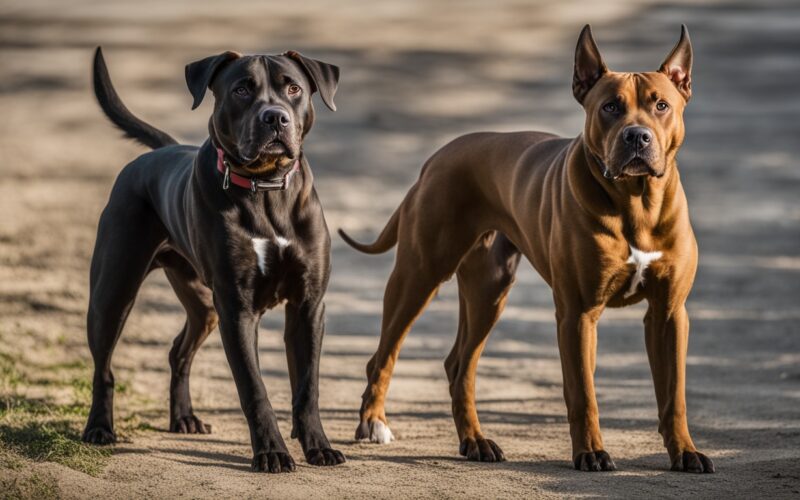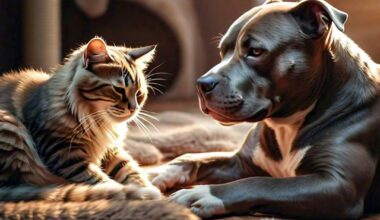What is a pitbull? Pitbulls have been a big part of American life for over 200 years. This fact shows how deep their history goes in our society. From their start in the early 1800s to now, they’ve changed a lot.
The term “pitbull” covers many dog types. To understand pitbulls, we need to look at their varied origins, unique traits, and often misunderstood nature. These dogs are known for their strength and loyalty. They’ve been both praised and criticized over the years.
Exploring pitbulls reveals a breed with a rich history and a bright future. They’ve moved from being work dogs to beloved family pets. Let’s dive into the truth about this intriguing breed and see what makes pitbulls special.
The Origins and History of Pitbulls
The story of pitbulls is truly captivating, broad and spanning many centuries. This type of dog went from being referred to as fierce competitors in blood sports to loving family pets. Learning about their origins shows us their strength and ability to adapt.
From Bull Baiting to Companion Dogs
In the 19th century, England was the birthplace of pitbulls. Breeders crossed terriers with American bulldogs for bull baiting, a brutal sport banned in 1835. After the ban, these dogs found new roles because of their strength and loyalty.
The American Pit Bull Terrier Emerges
Before the Civil War, immigrants brought these pit bull-type dogs to America. By the 1930s, they became a unique breed. They were great at farming, hunting, and being family pets. Their eagerness to please made them favorites among working-class families.
Pitbulls in American Culture
Pitbulls were known as the “All American Dog.” They were mascots in World Wars I and II, with Sergeant Stubby being a hero. Famous people like Helen Keller had pitbulls, showing their kind nature. But, their image in media changed in the 1980s, affecting how people saw them.
“National Pit Bull Awareness Day, founded in 2007, promotes understanding and appreciation of the Pit Bull breed.”
Today, pitbulls are both loved and misunderstood. Over 700 U.S. cities have laws about pitbulls. Yet, these bull type dogs show their true nature as reliable allies, doing jobs from police work to therapy.
What Is a Pitbull: Breed Characteristics and Traits

Pitbulls are a unique breed with distinct characteristics. They are a mix of strength and affection. These attributes make them stand out.
Physical Appearance and Size
Pitbulls have a muscular build and a compact frame. The size of this animal varies between males and females. Male pitbulls are taller and heavier than females.
They stand 18 to 21 inches tall and weigh 35 to 60 pounds. Female pitbulls are smaller, measuring 17 to 20 inches tall and weighing 30 to 50 pounds. They have a short, smooth coat in various colors like black, white, brindle, and red.
Temperament and Personality
This animal’s nature is often misunderstood. These dogs are very affectionate and friendly. They are great with kids and very faithful to their families.
They have a playful nature and lots of energy. This makes them perfect for adoption by active households. Pitbulls are also smart and love to learn. They are easy to train because they want to please their owners and can be the the perfect foster pet ( click here to read more ).
Intelligence and Trainability
Pitbulls do well in obedience and dog sports because of their athletic abilities. They love to learn and respond well to positive reinforcement. Early habituation and consistent training are important for a well-behaved pitbull.
With the right guidance, these animals can learn many tasks. They can be skilled in tracking, agility, and even therapy work.
“Pitbulls are ranked as the fourth most gentle breed by the American Temperament Test Society, challenging common misconceptions about their nature.”
Understanding these pitbull behavior can help you care for your furry friend. Every dog is unique. With love and proper training, pitbulls can be great family pets.
Dispelling Myths and Misconceptions About Pitbulls
Pitbull myths have long clouded public perception of these misunderstood dogs. Let’s shed light on some common pitbull misconceptions and explore the truth about pitbull nature.
“Pitbull” isn’t a single breed but an umbrella term. It includes the American Pit Bull Terrier, American Staffordshire Terrier, and others. This confusion often leads to misidentification, with studies showing Pitbulls are wrongly identified about 60% of the time in shelters and media reports.
One persistent myth is that Pitbulls have “locking jaws.” This is false. No dog breed has this anatomical feature. Another misconception is their inherent aggression. In fact, Pitbull breeds score 85% or higher in personality tests for positive human interactions.
- American Staffordshire Terriers rank high for being “affectionate with family” (AKC)
- American Pit Bull Terriers score 87.4% on average in the temperament tests
- Pitbull breeds often outscore traditional “family dogs” in these tests
While some studies suggest Pitbull attacks can be more severe, it’s crucial to note that 72% of dog bite fatalities are caused by non-Pitbull breeds. Factors like proper training, socialization, and responsible ownership play a significant role in any dog’s behavior, regardless of breed.
“The majority of Pitbull breeders today appreciate their gentle and adorable nature, moving away from their historical dogfighting roots.”
By understanding these facts, we can challenge pitbull myths and appreciate these dogs for their true nature. Remember, a dog’s individual personality and upbringing matter more than breed stereotypes.
Responsible Ownership and Care for Pitbulls
Owning or adopting a pitbull means you have special duties. These dogs need the right care to be happy and healthy. Let’s look at the main parts of raising a joyful, healthy pitbull.
Exercise and Mental Stimulation Needs
Pitbulls are lively dogs that need exercise every day. They should get at least 2 hours of good time each day for play and activity. This helps stop bad behavior and keeps their minds sharp. Great activities include swimming, running, and playing.
Socialization and Training Tips
Getting your dog used to different situations early on is crucial. This helps them not be scared later on. Pitbulls are great at learning commands like sit, stay, and come. Training them well makes a strong connection between you and your pet.
Health Considerations for Pitbulls
Seeing the vet regularly is important for pitbulls. They might get hip dysplasia. Eating right and staying active keeps them healthy. Getting your dog neutered or spayed can also stop territorial aggression and prevent unwanted litters.
“Pit Bulls are listed by the American Canine Temperament Test Society as having one of the most stable temperaments of any purebred, comparable to golden retrievers, making them excellent family dogs.”
Being a responsible pitbull owner means more than just loving them. It means committing to training, socializing, and caring for their health. With the right care, your pitbull can be a loving, loyal friend for many years.
Conclusion
Understanding the pitbull breed is crucial for responsible ownership. These dogs, often seen as misunderstood, include three breeds: Staffordshire Bull Terrier, American Staffordshire Terrier, and American Pit Bull Terrier. They were not only used in blood sports but also commonly used as family pets and farm helpers, showing their versatility.
Proper care for this animal means knowing they’re not naturally aggressive. Their behavior comes from how they’re raised and their surroundings. With the right training and socializing, pitbulls become loyal and loving friends. They are great at activities like weight pulling and swimming, showing off their strength and agility.
If you’re thinking about getting a pitbull, remember they have special needs. They need a balanced diet, regular exercise, and mental challenges. Pitbull puppies need lots of energy and benefit from controlled exercises that help build their strength slowly. Giving them the right care and clearing up myths can help ensure a bright future for this breed.








30 comments
Your article helped me a lot, is there any more related content? Thanks!
Your point of view caught my eye and was very interesting. Thanks. I have a question for you.
Your article helped me a lot, is there any more related content? Thanks!
Thank you for your sharing. I am worried that I lack creative ideas. It is your article that makes me full of hope. Thank you. But, I have a question, can you help me?
Thank you for your sharing. I am worried that I lack creative ideas. It is your article that makes me full of hope. Thank you. But, I have a question, can you help me?
I don’t think the title of your article matches the content lol. Just kidding, mainly because I had some doubts after reading the article.
Can you be more specific about the content of your article? After reading it, I still have some doubts. Hope you can help me.
Thank you for your sharing. I am worried that I lack creative ideas. It is your article that makes me full of hope. Thank you. But, I have a question, can you help me?
Your point of view caught my eye and was very interesting. Thanks. I have a question for you.
Within this platform, you can discover a variety of online casinos.
Interested in well-known titles new slot machines, you’ll find an option to suit all preferences.
All featured casinos are verified to ensure security, allowing users to gamble peace of mind.
vavada
Moreover, this resource offers exclusive bonuses along with offers to welcome beginners as well as regulars.
Due to simple access, locating a preferred platform is quick and effortless, making it convenient.
Keep informed regarding new entries with frequent visits, as fresh options appear consistently.
I don’t think the title of your article matches the content lol. Just kidding, mainly because I had some doubts after reading the article.
I don’t think the title of your article matches the content lol. Just kidding, mainly because I had some doubts after reading the article.
Коллекция Nautilus, созданная Жеральдом Гентой, сочетает элегантность и прекрасное ремесленничество. Модель Nautilus 5711 с самозаводящимся механизмом имеет 45-часовой запас хода и корпус из белого золота.
Восьмиугольный безель с округлыми гранями и синий солнечный циферблат подчеркивают неповторимость модели. Браслет с интегрированными звеньями обеспечивает комфорт даже при повседневном использовании.
Часы оснащены функцией даты в позиции 3 часа и сапфировым стеклом.
Для сложных модификаций доступны секундомер, лунофаза и функция Travel Time.
Продать часы Патек Филипп Nautilus тут
Например, модель 5712/1R-001 из розового золота с механизмом на 265 деталей и запасом хода до 48 часов.
Nautilus остается символом статуса, объединяя инновации и классические принципы.
Thanks for sharing. I read many of your blog posts, cool, your blog is very good.
Your point of view caught my eye and was very interesting. Thanks. I have a question for you.
Thanks for sharing. I read many of your blog posts, cool, your blog is very good.
Your point of view caught my eye and was very interesting. Thanks. I have a question for you.
Your point of view caught my eye and was very interesting. Thanks. I have a question for you.
Can you be more specific about the content of your article? After reading it, I still have some doubts. Hope you can help me.
Thanks for sharing. I read many of your blog posts, cool, your blog is very good.
Thanks for sharing. I read many of your blog posts, cool, your blog is very good. https://www.binance.com/sk/register?ref=OMM3XK51
Thanks for sharing. I read many of your blog posts, cool, your blog is very good. https://www.binance.info/en-ZA/register-person?ref=JHQQKNKN
Your article helped me a lot, is there any more related content? Thanks! https://www.binance.info/es-MX/register-person?ref=JHQQKNKN
Your article helped me a lot, is there any more related content? Thanks!
Thank you for your sharing. I am worried that I lack creative ideas. It is your article that makes me full of hope. Thank you. But, I have a question, can you help me? 注册以获取100 USDT
Thank you for your sharing. I am worried that I lack creative ideas. It is your article that makes me full of hope. Thank you. But, I have a question, can you help me?
Thanks for sharing. I read many of your blog posts, cool, your blog is very good.
Your article helped me a lot, is there any more related content? Thanks!
Can you be more specific about the content of your article? After reading it, I still have some doubts. Hope you can help me. https://www.binance.info/register?ref=IXBIAFVY
Thank you for your sharing. I am worried that I lack creative ideas. It is your article that makes me full of hope. Thank you. But, I have a question, can you help me?